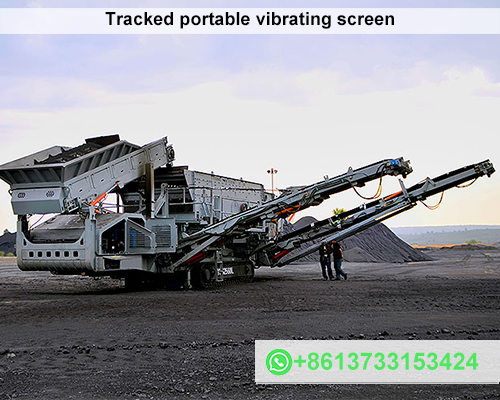New design in tracked portable vibrating screen
The demand for efficient material handling and sorting in industries such as mining, construction, and recycling has driven continuous innovation in screening technology. One of the most important developments is the tracked portable vibrating screen, which combines portability with robust performance in challenging environments. The new designs emerging in this field are setting a high standard by addressing the limitations of traditional screens, enhancing mobility, increasing productivity, and lowering operational costs.

Key Features of the New Design
1. Mobility and Versatility
The primary advantage of a tracked vibrating screen over its stationary or wheel-mounted counterparts is its enhanced mobility. With the inclusion of rubber or steel tracks, these screens can be deployed across a variety of terrains, from urban construction sites to remote quarries. The tracked design allows easy navigation over rough, uneven ground without the need for external transportation equipment.
New designs focus on improving the track system to provide better stability and reduced ground pressure. This minimizes damage to sensitive surfaces while increasing the operational footprint, making it feasible to operate in tight spaces or rugged environments where conventional equipment would struggle.
2. Innovative Screening Technology
At the heart of any vibrating screen is the screening deck. Recent design innovations have improved the screen’s efficiency in separating different material sizes, reducing downtime, and lowering energy consumption.
a) High-Frequency Vibrating Mechanism
The new design incorporates a high-frequency vibrating mechanism, which improves separation efficiency for smaller particles. High-frequency screens create rapid vibration cycles, causing the material to stratify more quickly, allowing finer particles to pass through the screen while keeping larger particles moving across the deck for further screening.
b) Adjustable Deck Angles and Configurations
To cater to different material types, some designs offer adjustable deck angles and modular configurations. This adaptability allows operators to fine-tune the screen to meet specific material requirements. Additionally, multiple deck options (2-3 layers) can process different materials in a single pass, improving output capacity.
3. Enhanced Durability and Low Maintenance
Operating in rugged conditions places significant wear and tear on screening equipment. New portable vibrating screens are designed with durability in mind, using advanced materials such as high-tensile steel for the frame and deck components. These materials extend the equipment’s lifespan while reducing the frequency of part replacements.
Self-cleaning screen media and dust-reducing mechanisms are also integrated into the design to reduce the accumulation of debris and clogs. These features result in lower maintenance costs and less downtime, which is crucial in high-output environments where operational delays can be costly.
4. Power Efficiency and Eco-Friendly Operations
In response to increasing environmental concerns, the new generation of vibrating screens emphasizes fuel efficiency and reduced emissions. By using energy-efficient motors and hydraulic systems, the equipment minimizes its carbon footprint while maintaining high throughput rates. Some models even incorporate hybrid systems, combining diesel and electric power sources, offering flexibility depending on the availability of external power and reducing operational costs.
5. Automation and Control Systems
Automation is revolutionizing every aspect of heavy equipment, and vibrating screens are no exception. New designs incorporate advanced control systems, allowing operators to monitor and adjust the screen’s performance in real-time.
Some innovations include:
- Remote monitoring capabilities, enabling operators to adjust settings or shut down the machine from a control room or offsite location.
- Predictive maintenance features that use sensors and data analytics to predict mechanical issues before they lead to costly breakdowns.
- Auto-leveling mechanisms that allow the screen to automatically adjust to terrain changes, ensuring optimal performance in varied environments.
6. Compact Design for Transportability
Transporting large industrial equipment has always posed logistical challenges. However, the new tracked portable vibrating screen designs emphasize compactness and ease of transport. The screen can fold into a smaller footprint, allowing it to be towed easily without the need for permits in certain regions. Furthermore, quick setup mechanisms enable operators to deploy the screen rapidly, saving time and labor costs.
Applications and Industry Impact
Tracked portable vibrating screens have a wide range of applications across industries:
- Mining and Aggregates: Used for screening crushed rock, ore, sand, and gravel, vibrating screens separate material efficiently, reducing the need for secondary crushing and improving overall productivity.
- Construction and Demolition Waste Recycling: These machines help in sorting different materials like concrete, asphalt, wood, and metal, facilitating better material recovery and reuse.
- Soil and Organic Materials Processing: Vibrating screens can process soil, compost, and other organic materials in landscaping and agricultural applications.
The new designs in tracked portable vibrating screens are having a profound impact on these industries by enabling faster project completion, more precise material handling, and enhanced operational efficiency.
Conclusion
The latest developments in tracked portable vibrating screens represent a significant step forward in material screening technology. By integrating mobility with robust screening capabilities, enhanced durability, and advanced control systems, these machines are setting a new standard in operational efficiency and adaptability. The continued evolution of this equipment promises to improve the productivity and sustainability of industries relying on material sorting and handling in demanding environments. As technological advances continue, the future of portable vibrating screens looks promising, with even more sophisticated designs on the horizon.








